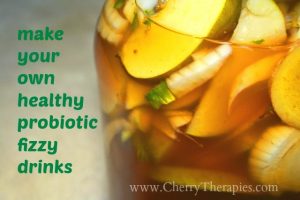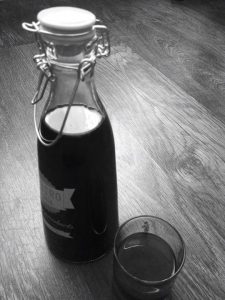 Koffucha is probably not a word you’ve heard much before (if ever). It’s a variation of ‘Kombucha‘, which is a probiotic drink made from fermented tea.
Koffucha is probably not a word you’ve heard much before (if ever). It’s a variation of ‘Kombucha‘, which is a probiotic drink made from fermented tea.
That might not initially sound very appetising to you, but trust me, Koffucha is completely delicious!
Some people use regular coffee to make koffucha, but I am really sensitive to caffeine so I started experimenting and making it with various herbal teas and coffee substitutes such as roasted dandelion root. I’ve had my fair share of kitchen disasters during my crazy fermentation experiments, but I have found dandelion root works very well.
Healthy soda
There’s something about fizzy drinks that everybody seems to love. Whether it’s coca cola, lemonade, beer, or even Scotland’s favourite soft drink Irn Bru (did you know that Scotland is the only country in the world where another drink outsells coke? Go Scotland!!), everyone loves that refreshing taste of something sweet and fizzy.
The only problem is, of course, that most sodas contain unhealthy ingredients like aspartame and phosphoric acid, and have been linked with serious health problems such as obesity, tooth decay, and diabetes.
The good news is that you can make your own DIY fizzy drinks like Koffucha with natural ingredients that actually promote good health and even help you to lose weight. It’s easy once you get into the swing of it – before you know it you’ll be having lots of fun creating your own flavours of koffucha.
Here’s how to get started:
How to make dandelion root koffucha
1st ferment:
Ingredients
1 cup of starter tea
2 litres pure water (distilled, spring, filtered, etc – whatever your preference)
4 tablespoons roasted dandelion root
1 cup of sugar (I use rapadura, but you can also use white sugar – in fact the cultures actually prefer white sugar, but I can’t quite bring myself to use it!)
A note on sugar: as a health-conscious person, it can be a bit off-putting to see so much sugar in a recipe. Kombucha (or koffucha) is literally the only time I use sugar as an ingredient.
The thing to remember is that the sugar is there to feed the micro-organisms in the kombucha – they don’t like it if you try substituting with other sweeteners such as stevia or xylitol! Don’t worry – during their metabolism process they magically convert most of the sugars to probiotics and other wonderful healthy substances so it’s a pretty good trade-off.
Equipment
1 wide-mouthed glass jar, large enough to hold in excess of 2 litres of liquid
Cotton or muslin cloth (wide enough to cover the mouth of the jar) and an elastic band to hold it in place
Process
Sterilise / thoroughly wash your glass jar and cloth. Make sure they are well-rinsed, as any soap residue could affect the culture.
Add half the water to a large pan, plus the dandelion root coffee and the sugar.
Bring to the boil and leave to simmer with the lid on for around 30 minutes.
Leave to cool slightly and strain the liquid (you can throw the dandelion roots into the compost).
Pour the other half of the water into the glass jar and add the strained brew (I add the cold water first so the glass jar doesn’t crack due to the hot water)
Check the temperature of the liquid is cool enough to comfortably put your (clean!) finger into (if the water is too hot for you, then it’s too hot for the scoby!)
Carefully add the scoby into the liquid (it’s important not to let any metal directly touch the scoby as this can contaminate it, so remove any rings before you touch it) and add the starter tea.
Cover the glass jar with the cloth and place it carefully into a warm dark cupboard. Leave it there for 7 – 10 days.
Try not to move the jar at all during this time; the process works best when the koffucha is left undisturbed.
After at least a week has passed carefully remove your jar from the cupboard, pour out a little of the brew and taste to check if it is ready. If everything is ok, gently take out the scoby (you may have an extra scoby now if it has had a ‘baby’) and pour the liquid into another large glass jar. You are going to add extra ingredients so you may want to split it between 2 large jars, to comfortably fit everything in.
You can drink this ‘as is’ for an iced coffee-type beverage, or you can now have some fun experimenting with a ‘2nd ferment’ to add flavour and extra fizz.
Here is one of my favourite koffucha recipes – it tastes just like coca-cola to me!
Dandelion root koffucha – 2nd ferment
Ingredients
2 litres roasted dandelion root koffucha (see recipe above)
3 apples, chopped (I advise using organic ingredients whenever possible)
3 dried figs
Juice of 2 limes
2 tablespoons raw cacao / chocolate powder
2 T maple syrup
Small handful chopped fresh fennel
1 cup coconut water
1 inch chunk of ginger root
3 sticks cinnamon
2 teaspoons star anise
2 teaspoons vanilla bean paste
1 teaspoon mixed spice
1 teaspoon peppermint essence
1/2 teaspoon nutmeg
5 drops vanilla stevia
5 drops chocolate stevia
Add all ingredients into the koffucha liquid, cover the jar, and leave to ferment for 1 or 2 days (or to your own taste).
If you don’t have all the ingredients to hand, don’t worry, just add whatever you have or make substitutions as you see fit. The 2nd ferment is much more free and easy than the 1st ferment, as you don’t have to worry about maintaining the correct environment for the scoby. This part of the process is simply about the flavour!
After the 2nd ferment is done, strain the liquid into bottles and store in the refrigerator. Airtight lids will increase fizziness, but be careful and check them often, loosen the tops from time to time to let them ‘breathe’, otherwise you may find yourself with an explosion!
(By the way, don’t throw away all those ingredients that you used in the 2nd ferment – pop them in a saucepan of water and simmer for a while to make a nice pot of chai tea.)
It is very difficult to gauge how fermented drinks will turn out, flavour wise. Their taste will vary depending on room temperature, length of fermentation, type of ingredients used, and even what kind of mood they are in (they are living organisms, after all)! So I encourage you to keep experimenting with your brews according to your own taste.
Have fun, and let me know how your brews turn out in the comments below!
Please note: if you are completely new to making fermented drinks, then I advise you to get some practice first and build your confidence in making normal kombucha before you move onto different variations. It’s a good idea to get familiar with how the drink should look / taste before you start branching out into more unusual recipes. Also it gives you time to build up a good stock of spare cultures (also known as ‘scobys’).
Kombucha is traditionally made from green or black tea, and using anything other than that can sometimes lead to the ferment going amiss. If you are experienced in kombucha brewing you should be able to identify if your brew has failed in some way, and take appropriate action. Click here for detailed instructions on making regular kombucha or see below for further resources.
I usually make a batch of kombucha using green or black tea, as well as my batch of ‘alternative’ kombucha (eg made with herbal tea or dandelion root). That way I always have a good supply of spare scobys if any of my batches go wrong, plus I always have an awesome variety of delicious drinks on hand!
Here are some further useful resources on kombucha:
http://www.seedsofhealth.co.uk/fermenting/index_kombucha.shtml
http://www.happyherbalist.com/kombuchamushroom.aspx
http://users.bestweb.net/~om/kombucha_balance/ (some great troubleshooting advice here)
http://users.bestweb.net/~om/kmi/skin-hair.html (some interesting alternative uses for spare scobys)
http://www.seedsofhealth.co.uk/fermenting/kombucha_teas.shtml (information on the different types of tea to use for kombucha)
http://www.culturesforhealth.com/kombucha-ingredients (advice on the best ingredients to use for kombucha)


What ingredients are in the mixed spice you use? I could see this going terrible wrong if I used the wrong mixed spice. Thanks!
Hi Marilyn! I must confess, it was quite a while ago so I can’t remember exactly what was in the mixed spice! I would guess it was a mixture of cinnamon, nutmeg, ginger and cloves. It’s worth having an experiment and seeing which comes out best. Good luck!
I am ready to add my spices to my brew. I started it about 3 weeks ago. It tastes perfect. Question: I remove the scobey with some liquid to a “hotel” before I add the spices? Then do I screw on a cap or continue with a paper towel and rubber band, it’s in a gallon jar. Let that sit 2 days then strain and place in second fermentation air lock container on counter for a few days before going in the fridge? Just wanna make sure I get these next step street.
Hi Debbie, congrats on your perfect brew! Yes I would remove the scoby to a hotel before adding spices to your brew. I would pop a paper towel and rubber band on the scoby. For the ‘new’ brew with spices, you could use paper towel and rubber band for a couple of days, then screw on cap / airlock and put in fridge. They don’t really mind, aerobic or anaerobic is all good. The main thing to watch out for is if you leave the finished brew for too long without letting it ‘breathe’, then it can explode if you’re not careful – lots of mess!
Hey! So just to clarify. The dandelion goes into the first ferment? If so, do you use any black tea with it or this recipe essentially swapping black tea for dandelion root?
I see this: starter tea=black tea/camelia sinensis?
1 cup of starter tea
…
…
4 tablespoons roasted dandelion root
Hey Josh, thanks for your question. Yes the dandelion goes into the first ferment, as an alternative to black tea. You could add in a little black tea if you weren’t worried about keeping the brew caffeine-free. Hope this helps, enjoy your kombucha experiments 🙂